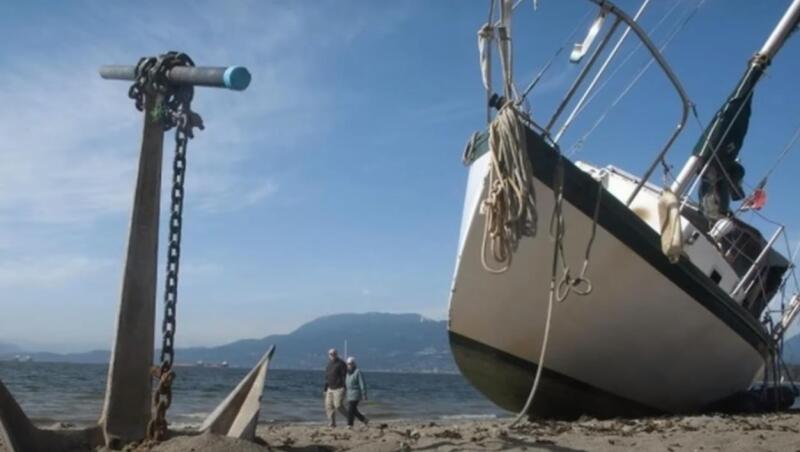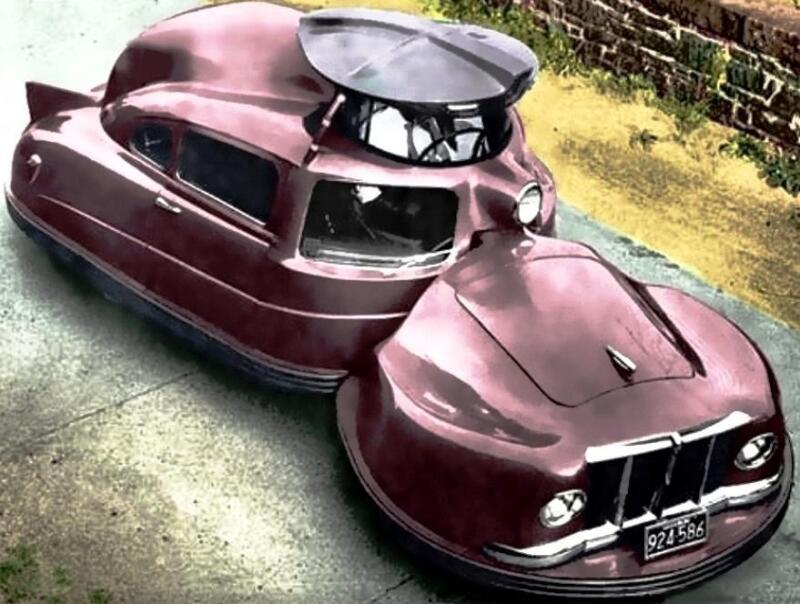From the history
It is not known exactly when this device appeared. The first anchors were made of stone, wrapped with lianas, and then with ropes. Later learned to make holes. Iron was used to make anchors around the XNUMXth century. BC e. Who invented it? Here the opinions of historians differ: some believe that it was Eulampius from Ancient Greece, others are sure that the honor of inventing the anchor belongs to the Scythian Anacharsis and even the Phrygian king Midas.
 This is what the stone anchor looked like. Photo: YouTube.com
This is what the stone anchor looked like. Photo: YouTube.comBe that as it may, the device quickly spread throughout the Mediterranean Sea, which served at that time for the movement of merchant ships. Later, the anchor spread throughout Europe. But where did this word come from? In German, English, Italian, Swedish and other languages, the name of this device sounds approximately the same: “anker”, “enker”, “ankuri”, etc. These words are translated into Russian as “curved”, “bend”. There are a number of versions of how the "anchor" turned into an "anchor". Perhaps it was more convenient for a Russian person to say this. On the other hand, there were such words as "snag" and hook - "zakor".
Anchor divers and modernization
Now they are in the past. But the first devices, similar to modern ones, at first had one horn, which might not catch on the bottom. So there was a special diver. He had to jump after the descending anchor in order to “stick” it into the ground. However, this was possible only at shallow depths. It was required that when the rope or chain was pulled, the anchor itself would cling to the bottom. This is how the “two-horned” device appeared, which is considered a classic and is used to this day.
What is an anchor for?
It seems that its only function is to keep the ship in one place. However, this device is in demand in other cases. For example, there are "verps" that help to refloat the ship and move against the current. They also use the so-called. "dead" anchors that serve for long-term fixing of objects on the water - buoys, beacons and ships drilling on the shelf.
 Anchor in a regular place - in the clouse. Photo: YouTube.com
Anchor in a regular place - in the clouse. Photo: YouTube.comThe same devices that hold specialized ships (bottom deepeners or miners) are called "deliveries". The next type is auxiliary anchors. Usually they are located at the stern; their function is to keep the ship from turning around. Well, those "pieces of iron" that everyone is used to seeing and which "creep out" of the nasal openings of ships (cleats) are called "stands".
Design
It may be different, but still the main elements are present in any device:
✅ spindle - the basic basis of the product
✅ a bracket with a ring (eye) is needed to connect to a cable or chain
✅ the horns hold the anchor in the ground and end with paws with a point (sock)
✅ not all devices have a stock - it is needed to turn them over in order to catch on the ground, and not lie flat.
The designs changed over the centuries until they took on several modern forms.
 These are just some of the anchor types. Photo: YouTube.com
These are just some of the anchor types. Photo: YouTube.comHowever, the fact is that all the changes that occurred with this device happened before our era, and there were no metamorphoses until the middle of the XNUMXth century.
Types of anchors
There are more than five thousand of them. That is how many official patents have been issued for the modernization of a popular device.
 Anchors popular with small craft owners. Left to right: Plow anchor, Hall and Bruce. Photo: YouTube.com
Anchors popular with small craft owners. Left to right: Plow anchor, Hall and Bruce. Photo: YouTube.comHowever, there are several types of anchors that are most common.
Admiralty
A true "classic". The product received its name in 1821. Then this type of restraint was approved for use on ships in the British Admiralty.
 Often the classic Admiralty anchor is used as a monument (Mozhaisk Park of Culture and Leisure). Photo: YouTube.com
Often the classic Admiralty anchor is used as a monument (Mozhaisk Park of Culture and Leisure). Photo: YouTube.comIndeed: an anchor of this design securely holds the ship in place. But there are also serious disadvantages:
✅ large mass does not allow hanging the device from the outside: it must be thrown over the bulwark by removing the stem
✅ when the wind or current changes, there is a risk of winding the chain on the paw and breaking the anchor
Therefore, the desire of sailors to create a more perfect design is understandable. At the same time, there were attempts to make an anchor:
✅ collapsible and without a stem, which is convenient for use, storage
✅ with movable horns for better anchoring in the ground
✅ with different paw configuration
Several designs have been developed, named after their creators.
Anchor Hall
This is a stand-type device, most often used on ships of the Navy. The retractable design is distinguished by the presence of swivel legs and the so-called cast together with them. box. A spindle is connected to it through hinges; its shaft is limited by semicircular holes. There are also a couple of studs located on the opposite side. How does it all work?
 Hall's anchor is well suited for rivers in the Central Strip of the Russian Federation. Photo: YouTube.com
Hall's anchor is well suited for rivers in the Central Strip of the Russian Federation. Photo: YouTube.comAfter throwing, the anchor without a rod falls flat on the ground. Why does the drawing of the product begin, during which the paws actively burrow, simultaneously turning by 40-45 °. To make the process go faster, special tides are provided that press the product to the bottom. In perfect designs, there are paws that rotate around their axis. The Hall anchor, used on large vessels, is able to literally pierce the upper muddy layer of the bottom and go several meters deep until it reaches a solid surface.
 Hall anchor in action. Photo: YouTube.com
Hall anchor in action. Photo: YouTube.comEverything seems to be perfect, but there are cons. If the bottom is not uniform, there is a risk of the anchor being pulled out due to its rotation during the dive. Sometimes the device holds the ship, thanks not to “sticking” into the ground, but due to the mound “made” by the paws, which is fraught with tearing out the product. And another drawback is the shape of the paws and spindle. Because of it, the device does not fit well into the clew, which can damage it.
Anchor Danforth
The principle of its operation is similar: like that of the "colleague" described above. But there are differences: the body is equipped with two swivel legs, having the shape of triangles. On the sides of the anchor there are tides that do not allow it to turn over and help to lie more densely on the bottom.
 On the left is Denforth's anchor. Photo: YouTube.com
On the left is Denforth's anchor. Photo: YouTube.comBest of all, Denfort's product works on sand or fine stony soil. The anchor is good at "slowing down" the ship, even if it turns 360 °. And the holding force of the device is 4 times higher than that of the classic Admiralty product, which has the same weight. Of the minuses, users note the possible jamming of the movable paws, poor fixation on the coarse rocky bottom. With a strong current, the device may fall not at all where it was expected.
Anchor with one paw
Why is it needed if it is better with two "hooks"? This device resembles the Admiralty "classics", with only one "horn": however, it is somewhat large. Such a “thing” is in demand on ships moving in ice. The only paw of the product (weight in the range of 50-150 kg) can be hooked on the hole or ledge of the hummock, securely holding the vessel. And what devices are suitable for small vessels (the above can also be used, only smaller dimensions)?
PVC boat anchors
The best option is a cat-type design. These were used in the Middle Ages, going to board an enemy ship. Anchor of this type is suitable for almost any bottom: rocky, sandy or even cluttered.
 Anchor-"cat" is universal in its own way. Photo: YouTube.com
Anchor-"cat" is universal in its own way. Photo: YouTube.comAlso, the device can be used to lift drowned nets, cables and other items by trawling. Some designs are foldable, which is convenient for storage, transportation. The only negative is that the product is not suitable for large vessels, because it has a low holding force.
 Floating anchor in action. Photo: YouTube.com
Floating anchor in action. Photo: YouTube.comAlso for small boats, the so-called. drogue. It will fix your boat, boat, raft bow to the wind in a drifting position. Such a device will be useful where there is great depth and a conventional anchor cannot reach the bottom.










